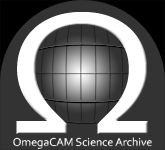 |
 |
| IFA ROE |
|
Home |
Overview |
Browser |
Access |
Login |
Cookbook |
|
Start here - primer to using the OSA
- Login info
- What is in the archive (coverage and data)?
- Accessing the data
- Accessing image data
- Accessing catalogue data
- Accessing meta-data
- Help
Categories of user access:
- registered VST survey user - Public Survey team members from ESO countries(eg the ATLAS community)
- un-registered user - can access VST survey data once the respective proprietary periods have passed (see data policy).
Archive contents The OmegaCam Science Archive contains static released databases of survey data. Image metadata and source catalogue data are held in the databases, with links to flat FITS files produced by pipeline processing. Once released, survey databases will not change. In addition to the static databases, access to a continually updating database (known as "OSA") is also allowed for registered users to get rapid access to pipeline-processed flat FITS files in order to facilitate casual browsing of survey data. Note however that this OSA ingest database is subject to data modification (ingest, rollback, quality control) without warning. After an appropriate proprietary period has expired, data and/or databases will become open-access for unregistered access by anyone. A more detailed description of the data and how it is held in the archive is given in the data overview. The contents of the various releases of the VST surveys are shown on the surveys page. More detailed coverage plots are available in the form of Multi-Order Coverage (MOC) maps.
Particular attention should be given to notes detailing limitations and known issues, see overview and release history.
The database schema and contents can be explored using the schema browser.
Accessing data - the various ways of accessing and querying the archive are also listed on the data access page. First-time users should consult this page in addition to reading the summary below.
- Image data - VST images (referred to as multiframes) are held in the archive
as multi-extension FITS files.
- Image List - list and retrieve the full FITS files of multiframes (also returns links to any associated catalogue FITS files)
- GetImage - extract image cut-outs from multiframes around a given position.
- MultiGetImage - upload a list of coordinates and extract matching image cut-outs.
- Catalogue data - source extraction code run on science multiframe images
produces catalogue FITS files. The objects in these files are ingested into the relevant
survey/programme detection table (e.g. atlasDetection). VST surveys also have a source table
(e.g. atlasSource) which is
populated by merging common objects (based on
position) across the various wavebands.
- Region search - search the catalogue data (detection or source tables) around a given position.
- Freeform SQL - submit an SQL query directly. Allows the more experienced user to perform powerful SQL searches of the archive (see the SQL cookbook for examples).
- CrossID - upload a list of coordinates and extract matching objects from the detection or source tables.
- Meta-data - header information and other meta-data from the archived FITS files are also stored in tables in the archive. The ones that are most likely to be used are multiframe, multiframeDetector and currentAstrometry. These can be queried using Freeform SQL
- Help - please consult the following documentation
before contacting us for help.
- Data overview - Description of how the data is processed, ingested and organised in the archive.
- Schema browser - in depth documentaion on the database schema (e.g. tabls and column names).
- Release History - record of releases including known issues/bugs.
- Questions and Answers - previously asked questions.
Home | Overview | Browser | Access | Login | Cookbook
Listing | FreeSQL
Links | Credits
WFAU, Institute for Astronomy,
Royal Observatory, Blackford Hill
Edinburgh, EH9 3HJ, UKosa-support@roe.ac.uk
23/4/2015